Strokes Gained: how analytics is changing how golf is understood
A version of this piece was first published in the Irish Examiner on Monday, April 14th, 2014: http://www.irishexaminer.com/sport/golf/simple-maths-opens-eyes-of-pros-to-where-real-value-lies-265311.html
In March of this year in one of the smaller rooms at Boston’s Hynes Convention Center, two men stood on stage. One was Sean Foley, golf coach to Tiger Woods; he stood a little way back as the other led the presentation to the 2014 Sloan Sports Analytics Conference. That other gentleman’s name was Mark Broadie and his ideas have changed the way in which coaches and players are analysing the game of golf.
Simple Stats for a Simple Game
At its core, golf is a remarkably simple game. From an agreed starting point
one tries to get a small ball into a hole by striking it with an assortment of oddly-shaped sticks as few times as possible. With a simple game came simple measures of effectiveness: fairways, greens and putts. So, if Alice took 26 putts for a round while Bob took 28, golf would decree Alice to have been the better putter.
“Counting putts is not good because a two-putt from 60 feet is a good outcome and a two-putt from one foot is terrible, but they both count as two putts”, said Broadie to his Boston audience.

Mark Broadie and Sean Foley present to the 2014 Sloan Sports Analytics Conference in Boston (photo credit: Sean Martin)
Greater Distance = Greater Difficulty
Distance is a key factor in putt difficulty, one which Broadie’s Strokes Gained method takes into account. It use millions of data points but the maths involved is surprisingly simple. “If the tour average from 33 feet is two putts, a one putt from 33 feet gains a stroke on the field” said Broadie. “That’s all it is. It’s subtracting two numbers – you take how many putts versus the baseline which is the tour average”.
“If the tour average from 33 feet is two putts, a one putt from 33 feet gains a stroke on the field”
The current tour leader in Strokes Gained Putting is Greg Chalmers (1.25), followed by Graeme McDowell (1.24), meaning each has gained one and a quarter strokes per round on the field this season through their putting alone.
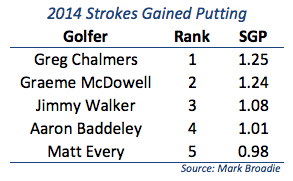 Strokes Gained Putting was introduced by the PGA Tour as an official statistic in 2011. “About two years ago I woke up and I saw this stat on the website: Strokes Gained putting. I had no idea what it meant so I called the PGA Tour and they told me about Mark”, said Foley. He called Broadie the next day to find out.
Strokes Gained Putting was introduced by the PGA Tour as an official statistic in 2011. “About two years ago I woke up and I saw this stat on the website: Strokes Gained putting. I had no idea what it meant so I called the PGA Tour and they told me about Mark”, said Foley. He called Broadie the next day to find out.
Answering Golf Questions With Maths
“I’ve been a golfer since I was a kid and my profession as an academic is applying math to real world problems, mainly financial problems”, said Broadie, a Professor of Business at Columbia Business School. “But I had this idea that I could use my mathematical background to answer some interesting golf questions.”
Humans have very unreliable memories. One crucial sunk putt on the 18th green of a Major’s final round can colour a television audience’s perception of that player’s putting skill forever. It can be easy to mistake most used for most important, and the putter is the most often used club in the bag. But it turns out that as a long term determinant of success putting really isn’t as important as very many people have thought.
“The biggest insight that Strokes Gained shows everyone is that the short game, and putting in particular, has always been overrated”, said Edoardo Molinari.
The Long Game is King
Broadie’s work has determined that for the top 40 PGA Tour golfers their driving and approach play contributed 68% of their Strokes Gained total as a group from 2004 through 2012, as opposed to just 15% for putting. Approach play alone contributed a whopping 40%, more than double the impact of putting.
the long game (driving and approach play) provides two thirds of the difference between the best PGA tour golfers and the average ones
The Strokes Gained figures are clear; the long game (driving and approach play) provides two thirds of the difference between the best PGA tour golfers and the average ones as well as between tour pros and good amateurs. Even when looking at good amateurs versus Saturday afternoon 18 handicappers, the two thirds rule holds true. “It’s the closest thing to a universal truth in golf”, wrote Broadie.
Is “drive for show and putt for dough” dead? Not quite. The ball must still get in the hole, after all. With every shot compared to a tour baseline based on distance and other factors, such as the difficulty of the course, shots of different types can now be compared against each other directly and between players. Strokes Gained simply demonstrates that the differences in putting between the best players in the world are slight compared to the differences between their driving and, in particular, their approach play from 100 yards and out.
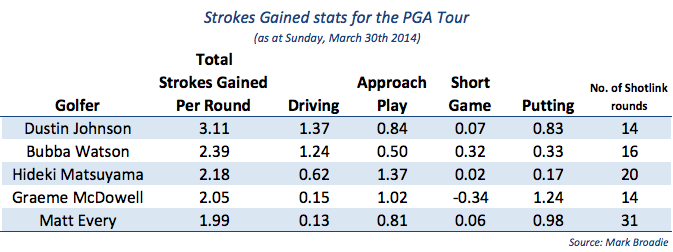 At its heart it’s is a way of telling us what we already know; some players are great at driving and some are great at putting.
At its heart it’s is a way of telling us what we already know; some players are great at driving and some are great at putting.
And Tiger Woods? “He’s great at everything” said Broadie. “That’s why he’s a stroke better than even the next person on this list which is just phenomenal. There’s just so many ways you can say how good Tiger is but if you had to point to one thing it would be his long approach shots that really separate him”.
The list to which Broadie refers is the top 40 golfers on the PGA Tour by Strokes Gained from 2004 through 2012, both in total and broken down by shot category: driving, approach play, short game and putting. He includes them in his book “Every Shot Counts” in which he details the Strokes Gained method as well as various strategy elements to the game.
Woods gained 2.79 strokes on the field per round over that time with Jim Furyk second at 1.84. That enormous gap, almost a full stroke per round, was greater than the gap between 2nd and 26th place. Over half of it was down to Woods’ approach play alone.
This kind of analysis, impractical just a decade ago, has been made possible through the availability of shot level data from ShotLink, implemented by the PGA Tour in 2003 in partnership with tech outfit CDW.
Since then the system has collected and archived over thirteen million shots ifrom tour play, and this dataset is catnip for anyone with an interest in golf and statistics. ShotLink feeds the tour’s broadcast partners, supplies live data for www.pgatour.com as well as the 11 Mitsubishi electronic scoreboards on each course. They also package it for various uses including non-commercial academic research.
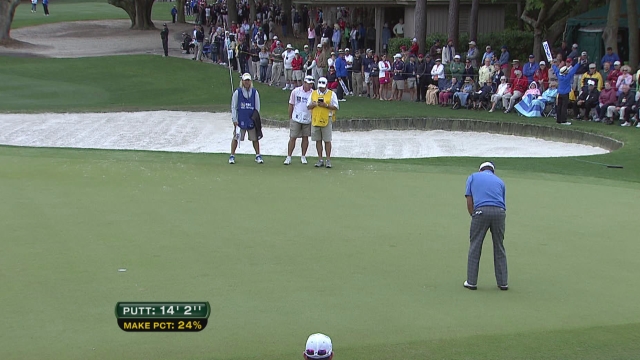
Graham McDowell with a 14’2″ putt at the 2013 RBS Heritage. Note the “Make Pct 24%”. Screengrab courtesy PGA Tour.
In 2012 the PGA Tour introduced the CDW ShotLink Intelligence Prize, won by Dr. Lou Riccio. “The paper that I did was similar to some of the analyses I did back in the 1970s and 1980s” said Riccio who, like Broadie, is of the Columbia Business School. Riccio’s paper on identifying the best ball strikers on the PGA Tour concentrated on approach play between 150 and 225 yards from the pin.
“What we’re talking about here is how you separate yourself from the pack. All the guys on the PGA Tour and the European Tour are incredible golfers. They’re all fantastic golfers. But they all bunch up, and then a couple of people dart out from the pack, and people like Tiger and Westwood and McIlroy dart out far more often than other players. And why is that? That’s what the search is for.”
More Strokes Gained Stats On The Way
Recovery shots are a potentially complicated wrinkleii. For example, if a player gets in trouble on the drive and their only option is to punch out into the fairway, arguably the errant tee shot should get all of the penalty but the base methodology would apportion it all to the second shot.
Those in charge of such things at the PGA Tour are taking their time to sort out these issues. “When it comes to new stats like these we are much more interested in getting it as close to right as we can than in getting it out the door fast”, said a tour spokesperson.
Do Players Really Care About Stats? And Should They?
Do the players really care? After all, as Foley said at the Sloan conference “Coaching is coaching – players don’t have to be smarter to be better, ultimately”.
Broadie says he is approached more often by coaches than players but there are certain players out there who are interested.
“I think that most people nowadays look at the Strokes Gained Putting stat”, said Italian golfer Edoardo Molinariiii.”In a few years you will have that same stat for every part of every player’s game and it will be much more simple to understand every player’s strength and weaknesses.”
Another Broadie devotee is the short game coach of former world number one Luke Donald, decidedly not one of golf’s long hitters. “If you’re Luke Donald and you’re his stature and have his speed, there’s only so far you can hit it. So for him to become the best player in the world, which he ultimately did, he has to make up those shots elsewhere” said Pat Gossiv, a numbers-friendly man with a degree in economics from Northwestern University, where he coaches the college golf team.
The mental side of golf has also been impacted. At Sloan, Sean Foley described how Justin Rose had been unhappy with his wedge game. Foley was able to use Broadie’s work as a platform to show Rose that he was in fact the number one on the PGA Tour from 100 yards in.
“He was so shocked and so surprised that he was number one in the short game” said Foley, whose experience with athletes is that they can start telling themselves stories, sometimes manifesting in an unhealthy and unwarranted self image.
No ShotLink at the Majors or on the European Tour
Alas, this is not yet golf’s holy grail of understanding. Quite apart from the physical and mental aspects of driving a golf ball 330 yards down the middle or standing over a slippery ten foot par putt on the 18th green, for the world’s top golf professionals there is a hole in the data.
“It would be great to have ShotLink added to the European Tour and the Majors”, said Molinari, with Pat Goss offering a similar opinion.
“It’s sorely missed over there” said Goss. “It’s something Luke Donald and I have discussed quite a bit because we have incredible data from the PGA Tour but we’re lacking valuable data from the Major championships and the European Tour. I know personally Luke and I would love to have that data. It would help us paint a better picture of his game.”
Where once the brassie, mashie niblick and gutta-percha were part of golf’s everyday lexicon, Strokes Gained is creeping in.
But amid such great advances in technology and understanding it will be comfort to some that the number crunchers don’t quite yet have all the answers.


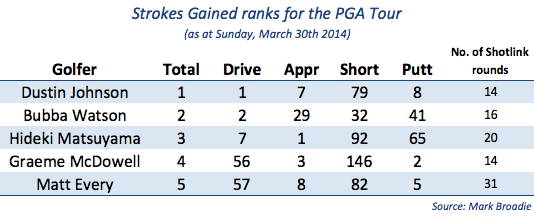
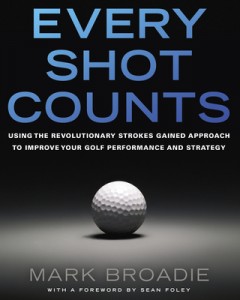

For the avoidance of doubt, Virtual Goods does not consist of any U.S.
Hi there, every time i used to check weblog posts here
early in the daylight, as i enjoy to learn more and more.